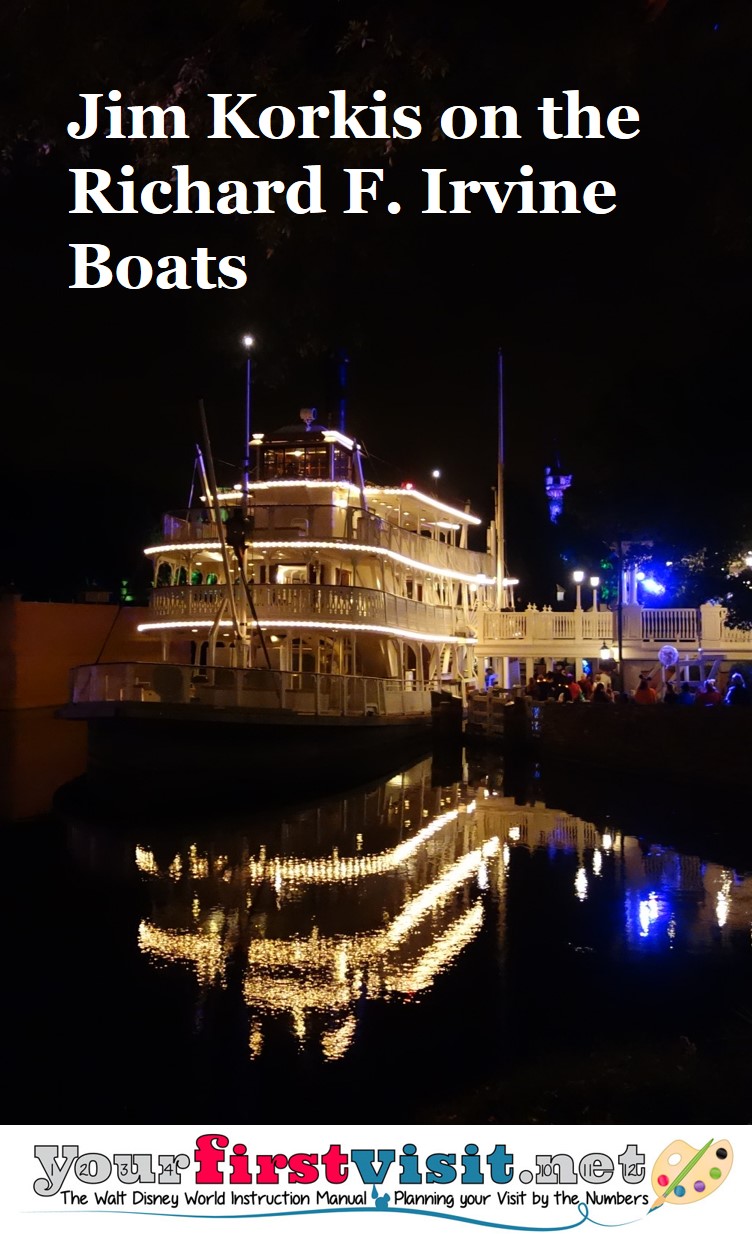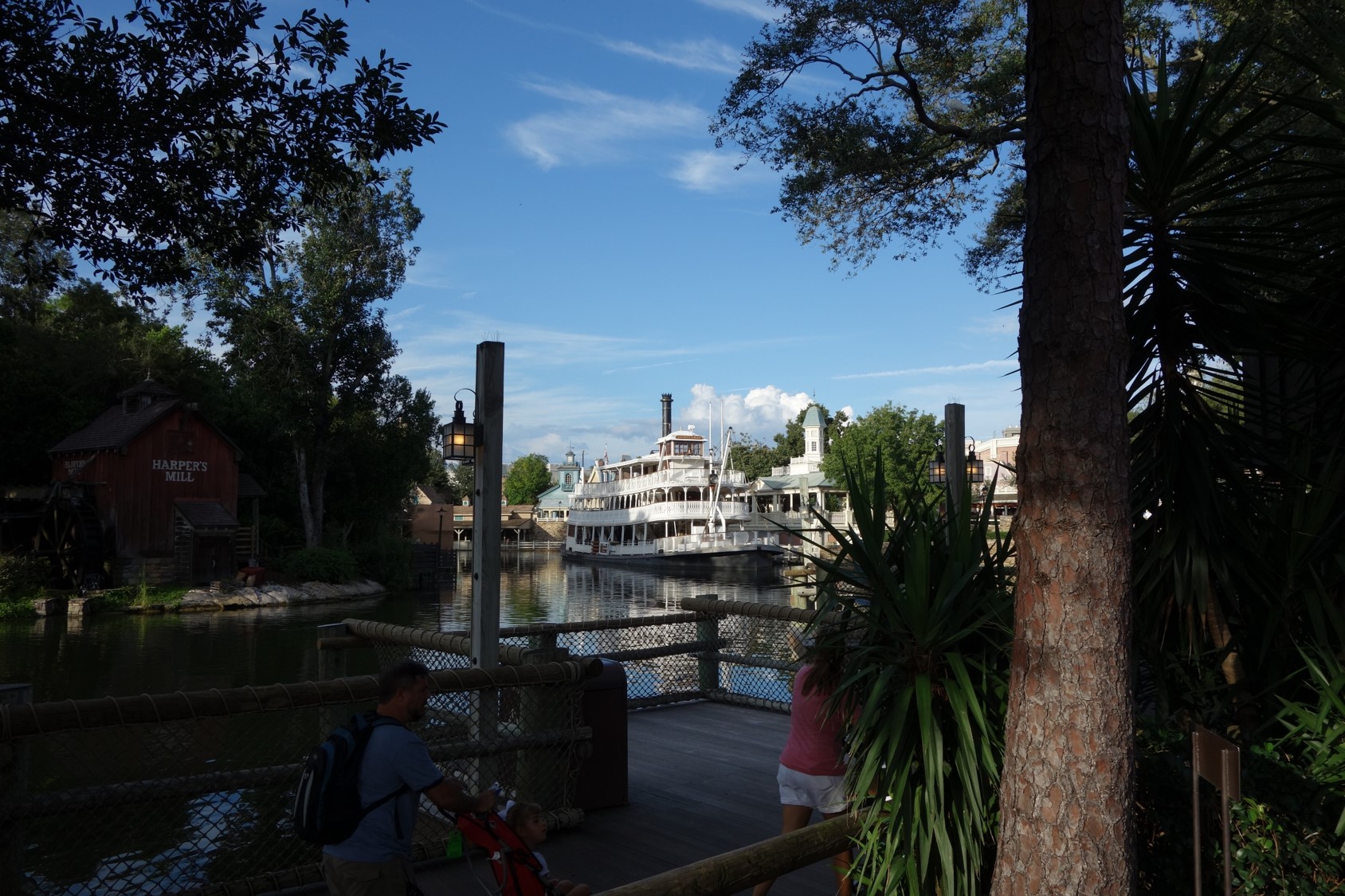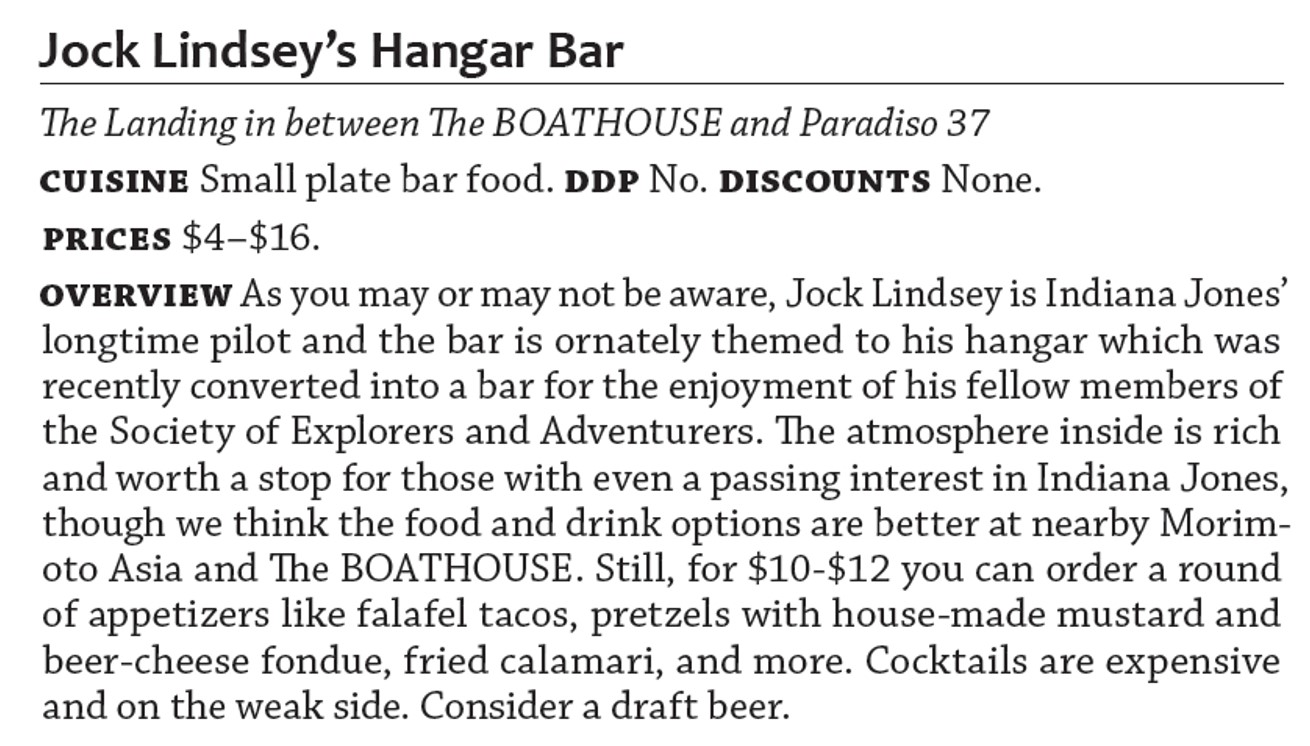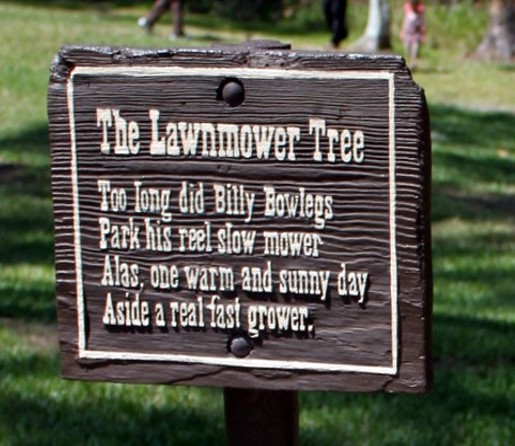Category — A Friday Visit with Jim Korkis
A Friday Visit with Jim Korkis: Cosmic Ray’s Starlight Café and Sonny Eclipse
Welcome back to Fridays with Jim Korkis! Jim, the dean of Disney historians and author of Jim’s Gems in The easy Guide, writes about Walt Disney World history every Friday on yourfirstvisit.net.
COSMIC RAY’S STARLIGHT CAFE AND SONNY ECLIPSE
By Jim Korkis
Cosmic Ray’s Starlight Café, a popular chain of intergalactic food and beverage franchises with a “galaxy of food choices,” has been open for business in Tomorrowland since 1994.
The restaurant was called the Tomorrowland Terrace until 1994. The original performer for the first decade was Michael Iseberg (aka Michael Iceberg) who amazed audiences with his frenetic performances using his early keyboard and synthesizer technology on his Amazing Iceberg Machine.
“This is the FIRST Earth Restaurant Franchise from Outer Space” proclaimed the original poster for what was the largest quick service location at the Magic Kingdom with its three food bays and extensive topping bar.
Guests dining in the Starlight Lounge Room on the lower level near the Alice in Wonderland tea cup attraction enjoy the song stylings and snappy banter of audio-animatronics lounge performer Sonny Eclipse (voiced by blues singer and songwriter Kal David) during his approximately twenty plus minute performance.
“Hey, speaking of planets, Donald Duck and Goofy were in here a few minutes ago looking for Pluto. Man, are they a few million miles off, or what?” remarks Sonny followed by the sound of canned laughter.
This Audio-Animatronics figure was actually modified from a similar figure, Officer Zzzzyxxx who was at the baggage screening desk outside of the Star Tours attraction at Tokyo Disneyland. Today, Disney refers to them as “cousins”.
Direct from Yew Nork on the planet Zork, Sonny Eclipse is the “Biggest Little Star in the Galaxy” according to his billing. The Bossa Supernova and Eclipso musical stylings of Sonny and his Astro Organ, along with his ethereal and invisible backup singers The Space Angels have entertained guests for over two decades. His unseen technician is named Mike Feedback.
During his act, Sonny mentions his six-eyed (all purple), twelve-nostrilled girlfriend who blows him away and he sings a little love song he wrote for her entitled “Oh Bright Little Star”.
The Metrophone booth from the Galactic Communications Network (GCN) located near the Tomorrowland Transit Authority PeopleMover connects guests to nine possible hilarious one-sided conversations including one with Johnny Jupiter who is Sonny’s agent.
Kal David had been working in Los Angeles with George Wilkins, who wrote a great deal of music for Disney. Wilkins brought David in to sing the song Unhealthy Living Blues for the Goofy About Health section in the Epcot Wonders of Life pavilion in 1989 and it went so well that brought David back to do Sonny Eclipse.
It was all done out of Wilkins’ Southern California home where he had set up a studio. Wilkins did all of the music on his synthesizer except for the guitar parts that were done by David. David was even able to incorporate a little of his famous blues guitar style in the song Gravity.
David worked for about three days. His female backup singers were The Brunettes, a group that featured David’s wife Lauri Bono who still tours with him today. The women worked for one day and were crammed into a small vocal booth that included Wilkins’ washer and dryer and one of the singers, Amy, was pregnant at the time.
“Everything was all written for me. There was no ad-libbing,” remembered David. “It was just another short studio gig and then you went back to your real life. They showed me a drawing of the character and encouraged me to just be myself. I loved him immediately and I had played in many bars over my career so I understood the ‘feel’ of how he would be.
“I could have done a cartoony voice but they just wanted my real voice pumped up a little. I like the songs but they are not the blues. I am proud to be the voice of Sonny. It has turned out to be the steadiest performing gig I ever had.”
* * * * *
Thanks, Jim! And come back next Friday for even more from Jim Korkis!
In the meantime, check out his books, including Secret Stories of Walt Disney World: Things You Never You Never Knew, which reprints much material first written for this site, and The Vault of Walt: Volume 4, and his contributions to The easy Guide to Your First Walt Disney World Visit, all published by Theme Park Press.
Follow yourfirstvisit.net on Facebook or Google+ or Twitter or Pinterest!!
April 22, 2016 1 Comment
A Friday Visit with Jim Korkis: The Richard F. Irvine Boats
Welcome back to Fridays with Jim Korkis! Jim, the dean of Disney historians and author of Jim’s Gems in The easy Guide, writes about Walt Disney World history every Friday on yourfirstvisit.net.
THE RICHARD F. IRVINE BOATS AT DISNEY WORLD
By Jim Korkis

The primary difference between the two ships was that the Fowler had two smokestacks, while the Irvine only had one. They both had three decks and a capacity of roughly 450 guests. They were actually functioning steamboats, propelled by their enigines, although they were guided by an I-beam underwater.
The original Fowler riverboat was damaged during a refurbishment at a backstage dry dock in 1980. It was broken up for scrap and the Irvine Riverboat in 1981 became the sole operating riverboat. In December 1982 the bell from the Fowler ship was installed on the Roy O. Disney engine on the Walt Disney World railroad.
In 1996, the Irvine was completely refurbished and returned to service as the renamed Liberty Belle Riverboat. The name change was to make its theme more closely to Liberty Square and make the name easier to remember.
Subsequently in 1999, one of the ferries that transported guests across the Seven Seas Lagoon to the Magic Kingdom was re-christened Richard F. Irvine so as to continue to honor the late Imagineer’s contributions while the other was rechristened the Admiral Joe Fowler. (The third was a tribute to General Joe Potter.)
The Irvine riverboat had been named after Richard Irvine who was born in Salt Lake City, Utah, on April 5, 1910. He moved with his family to Southern California in 1922.
He was the son of a prominent Los Angeles ophthalmologist, Alexander Irvine, who was Walt Disney’s personal eye doctor for years and was given a window on Disneyland’s Main Street.
“Dick” became an art director at 20th Century Fox and was hired by Walt in 1952 to act as liaison between Walt Disney Productions and an architectural firm that was being considered for designing Disneyland.
He had previously worked at the Disney Studios as an art director on Victory Through Airpower (194) and The Three Caballeros (194) so he knew how Walt worked and the Disney culture.
Imagineer John Hench recalled, “Because Dick had worked with movie set designs, creating structures and settings, he understood our needs more than standard architects.”
Dick headed design and planning for all Disneyland attractions, including significant contributions to the Haunted Mansion and Pirates of the Caribbean. He also guided the creation of attractions featured at the 1964-65 New York World’s Fair, including the it’s a small world attraction.
He went on to help shape the master plan and attractions for Walt Disney World and, in 1967, was appointed executive vice president and chief operations officer of WED Enterprises (now Walt Disney Imagineering).
Concerning Walt Disney World, Irvine told author Bob Thomas, “I often wonder how things would have been done differently if Walt had been alive. You know darn well, it would have been entirely different from what we did do.”
Before his death, Walt had put WED in charge of developing the theme park while he assembled a different group for the Epcot concept. Irvine was also involved in the creation and opening of California Institute of the Arts.
Irvine’s heart condition and resulting illness prevented him from attending the opening of Walt Disney World. He retired in 1973 and passed away March 30, 1976.
Irvine’s daughter Maggie Irvine Elliot became the Senior Vice President of Creative Administration at WDI. Dick’s son married Kim Thomas (now Kim Irvine, who currently is an art director at WDI) who is also Imagineer Leota Toombs’s daughter.
* * * * *
Thanks, Jim! And come back next Friday for even more from Jim Korkis!
In the meantime, check out his books, including Secret Stories of Walt Disney World: Things You Never You Never Knew, which reprints much material first written for this site, and The Vault of Walt: Volume 4, and his contributions to The easy Guide to Your First Walt Disney World Visit, all published by Theme Park Press.
Follow yourfirstvisit.net on Facebook or Google+ or Twitter or Pinterest!!
April 15, 2016 No Comments
A Friday Visit with Jim Korkis: General Joe Potter
Welcome back to Fridays with Jim Korkis! Jim, the dean of Disney historians and author of Jim’s Gems in The easy Guide, writes about Walt Disney World history every Friday on yourfirstvisit.net.
GENERAL JOE POTTER
By Jim Korkis
William E. “Joe” Potter was born in Oshkosh, Wisconsin, on July 17, 1905. He died on December 5, 1988, in Orlando, Florida, at the age of 83 of heart failure. He was inducted as a Disney Legend in 1997.
As former president of Walt Disney Attractions Dick Nunis recalled in 1988 to the Orlando Sentinel newspaper, “Joe was a man Walt Disney was very fond of. Without Joe Potter there would be no Walt Disney World today.”
It was General Potter who got the land in Central Florida prepared for building. Admiral Joe Fowler then was in charge of construction on the property.
Potter oversaw construction of the Walt Disney World Resort’s entire infrastructure. He supervised the building and operation of the underground utilities and sewer, power, and water treatment plants that were considered revolutionary at the time.
He also developed drainage canals for the entire property, which were known affectionately as “Joe’s ditches,” and kept the water table constant.
“I went out and got three crackerjack college professors to show me how to do it,” Potter joked in an interview a year before his death. “And then I got me another professor to help put the utilities underground.”
During World War II, Potter directed logistical planning for the invasion of northern France, a transportation operation nicknamed “Red Ball Express.” In 1956, President Dwight D. Eisenhower appointed Potter to serve as governor of the Panama Canal Zone.
At the end of his tenure as governor, and after 38 years with the United States Army, Potter retired as an Army Major General in 1960. In his long career, he had been decorated with the Distinguished Service Medal, the Legion of Merit, the Bronze Star, and the Croix de Guerre.
Soon after his “retirement,” he became executive vice president of the 1964-65 New York World’s Fair and was responsible for handling the construction of the federal and state attractions. These included 26 state pavilions and the $17-million United States pavilion.
At this time, he met Walt Disney (who had supplied attractions for four pavilions at the fair) who immediately realized that this was the man to be the vice president of his mysterious Florida Project and to prepare the land so it was suitable for construction.
“It didn’t take you long to realize that Walt was a beginner of things, not a finisher,” Potter said, meaning that Walt would spark the initial idea but depend on others to make it a reality.
Potter retired from Disney in 1974 as a senior vice president of Walt Disney World, as well as president of the Board of Supervisors of the Reedy Creek Improvement District. He later was president of Potter, Fowler and Associates Management Consultants and served on numerous civic and business boards, including the Greater Orlando Aviation Authority.
“I knew that we were going to have a project in Orlando many months before I joined Disney in September 1965,” stated Potter in 1976. “I had various functions. One was to establish the government, the Reedy Creek Improvement District. In that way, we were able to establish our own building department, develop our own building code, establish our own zoning, and do all of those things that are normally done by a county.
“You must realize that at the time Orange County did not have the facilities to examine plans for, let’s say, a castle. No complicated buildings had been built in Orange County so the county, of course, was not staffed to examine plans and conduct the inspections requiring all buildings meet the safety and welfare specifications of those buildings.
“We spend an enormous amount of time planning things and dissecting them, ‘committeeing’ them down darn near to death and then finally with approval, building them.”
* * * * *
Thanks, Jim! Most Disney World fans know that one of the ferries that travel the Seven Seas Lagoon is named after General Potter.
And come back next Friday for even more from Jim Korkis!
In the meantime, check out his books, including Secret Stories of Walt Disney World: Things You Never You Never Knew, which reprints much material first written for this site, and The Vault of Walt: Volume 4, and his contributions to The easy Guide to Your First Walt Disney World Visit, all published by Theme Park Press.
Follow yourfirstvisit.net on Facebook or Google+ or Twitter or Pinterest!!
April 8, 2016 No Comments
A Friday Visit with Jim Korkis: Indiana Jones in Disney Springs
Welcome back to Fridays with Jim Korkis! Jim, the dean of Disney historians and author of Jim’s Gems in The easy Guide, writes about Walt Disney World history every Friday on yourfirstvisit.net.
JOCK LINDSEY’S HANGAR BAR
By Jim Korkis
Some Disney fans do not fully understand that in 2012 Disney did not just buy the Star Wars franchise but the entire Lucasfilm catalog. That purchase included the beloved Indiana Jones character.
The first example of utilizing that acquisition is the creation of Jock Lindsey’s Hangar Bar in Disney Springs.
Jock Lindsey was a minor character in the movie Raiders of the Lost Ark (1981) portrayed by actor Fred Sorenson who rescued Indy from the Peruvian Hovito natives with his seaplane. The character was an American freelance pilot whose background was as a stunt pilot performing in Midwest airshows.
After a flight related tragedy, he relocated to Venezuela where he was often hired to fly archeologist Indiana Jones to remote locations. According to the original screenplay, he was supposed to be British. His pet was a Burmese python snake named “Reggie”.
According to the newly created Disney legend for the new bar in Disney Springs, Lindsey took Jones over Florida in 1938 to help hunt down the location of the fabled Fountain of Youth. Lindsey spotted a small town that he liked and returned in 1948 to establish an airplane hangar, air tower and runway on its waterfront, and operate an air tour service.
His fellow members of the Society of Explorers and Adventurers (S.E.A.) would drop by for an occasional drink, and in 1955 the area was officially established as a hangar bar and was littered with artifacts and memoribilia from their adventures.
The concrete bar top of the new bar is made to look as if it was once used as a work bench. Ceiling fans are made out of plane propellers, and walls are adorned with vintage travel posters and postcards and letters between Indy, Jock and other characters.
“He only had about a minute of air time in the original movie,” WDI Imagineer Theron Skees said, “and it was fun expanding on that. We were coming at it from the aspect that Jock is a pilot first and an adventurer’s guide second.”
In addition to references to the first three theatrical Indiana Jones movies, Jock Lindsey’s Hangar Bar also alludes to elements from the Expanded Adventures such as The Young Indiana Jones Chronicles and Indiana Jones and the Fate of Atlantis, and Jock Lindsey’s roles in Indiana Jones and the Tomb of the Gods and The Further Adventures of Indiana Jones story “The Sea Butchers.”
The bar also contains nods to other Disney properties including Star Wars, The Rocketeer and Iron Man, as well as references to famous aviators such as Amelia Earhart and Charles Lindbergh.
The bar’s address at 1138 Seaten Avenue, referencing a George Lucas feature film tradition to include in his works the number from his first theatrical film THX 1138 (1971).
From Raiders is the golden fertility idol at the top of the bar’s bookcase. The head piece for the staff of Ra is in the lost and found bin located near the bathrooms
From The Temple of Doom, Voodoo dolls of Indy, Short Round and Willie Scott are on a shelf. Also from that film is a coaster from Club Obi Wan in Shanghai, China. The cool-headed Monkey drink and souvenir mug reference the monkey brain eating sequence in the film.
From The Last Crusade, the image of the grail cup is on sign stating “artifacts no longer taken as payment”.
There are several references to Reggie, including an empty cage, a signature drink with a snake swizzle stick and an outside dry-docked steamboat named after the reptile.
The menu items have names that reference the films as well, including Rolling Boulder Sliders, Tanis Tacos, Lao Che’s Revenge, Dr. Elsa’s She-deviled Eggs, Hovito Mojito, Poisonless Dart, Brody’s Brats and many more.
Jock and Indy may be long gone, but this location honors their memories and cleverly immerses guests in their legendary adventures. With the addition of this bar, perhaps Jock may pop up in the new Indiana Jones movie that was recently announced.
* * * * *
Thanks, Jim!
Here’s the review of the bar from the just-released updated version of The easy Guide to Your First Walt Disney World Visit:
And come back next Friday for even more from Jim Korkis!
In the meantime, check out his books, including Secret Stories of Walt Disney World: Things You Never You Never Knew, which reprints much material first written for this site, and The Vault of Walt: Volume 4, and his contributions to The easy Guide to Your First Walt Disney World Visit, all published by Theme Park Press.
Follow yourfirstvisit.net on Facebook or Google+ or Twitter or Pinterest!!
April 1, 2016 No Comments
A Friday Visit with Jim Korkis: The Liberty Bell
Welcome back to Fridays with Jim Korkis! Jim, the dean of Disney historians and author of Jim’s Gems in The easy Guide, writes about Walt Disney World history every Friday on yourfirstvisit.net.
THE LIBERTY BELL IN LIBERTY SQUARE
By Jim Korkis
One of the most iconic representations of the early history of the United States originally rang from a steeple in the Pennsylvania State House (now known as Independence Hall).
The Liberty Bell was commissioned from the London firm of Lester and Pack (Whitechapel Foundry) in 1751 and displayed the phrase “Proclaim Liberty throughout all the land unto all the inhabitants thereof.” The phrase was from The Book of Leviticus (25:10) in the Bible.
The bell’s purpose was to summon lawmakers to legislative sessions and to alert citizens to public meetings and special announcements.
The City of Philadelphia turned over the custody of the bell to the National Park Service in 1948. The bell was moved to a nearby glass pavilion on Independence Mall in 1976 and then to the larger Liberty Bell Center in 2003.
One of the things that changed over the years at the Magic Kingdom was the entrance to Liberty Square from the Hub. In 1971, the Court of Flags representing the original 13 states led guests to the old Concord Bridge, where the colonial forces faced off with the British in 1775.
In 1991, those flags were relocated to surround the Liberty Bell that had been installed in 1989. The entrance to the land was rebuilt with the brick walls, plaque and guardhouse that are familiar today. Stanchions now fill the holes where the flagpoles once stood.
The bridge led to a public square that would still seem somewhat similar to guests visiting the park today. The double-stacked Admiral Joe Fowler Riverboat leisurely plied the Rivers of America starting on October 2, 1971.
It would be joined by the single stack Richard Irvine Riverboat in 1973 that is now called the Liberty Belle. Irvine was the WED Imagineer who was in charge of the attractions, while Fowler was in charge of supervising construction inside the park.
During the Bicentennial Celebration of the U.S. Constitution at Walt Disney World in 1987, one of the temporary displays in Liberty Square was an authentic reproduction of the original Liberty Bell loaned from the Mount Vernon Memorial Park and Mortuary of Fair Oaks, California through June of 1989.
However, Disney guests loved seeing the reproduction and taking photos with it so to provide a permanent display, Disney Show Properties and Interiors purchased a new replica. It was cast by Paccard Fonderie of Annecy, France using the original Liberty Bell mold. The new bell took its place of honor just before July 4, 1989 where it remains to this day.
The bell was made primarily of copper but also contains tin, lead, zinc, arsenic, gold and silver. It stands eight feet high, including stock, and weighs two and a half tons. The word “Pensylvania” was an accepted alternative spelling for “Pennsylvania” and appears on the original bell. Alexander Hamilton also used that spelling in 1787 on the signature page of the United States Constitution.
* * * * *
Thanks, Jim. Come back next Friday for even more from Jim Korkis!
In the meantime, check out his books, including Secret Stories of Walt Disney World: Things You Never You Never Knew, which reprints much material first written for this site, and The Vault of Walt: Volume 4, and his contributions to The easy Guide to Your First Walt Disney World Visit, all published by Theme Park Press.
Follow yourfirstvisit.net on Facebook or Google+ or Twitter or Pinterest!!
March 25, 2016 No Comments
A Friday Visit with Jim Korkis: The Lawnmower Tree
Welcome back to Fridays with Jim Korkis! Jim, the dean of Disney historians and author of Jim’s Gems in The easy Guide, writes about Walt Disney World history every Friday on yourfirstvisit.net.
THE LAWNMOWER TREE AT FORT WILDERNESS
By Jim Korkis
For several decades, a natural wonder delighted guests who came to Fort Wilderness Resort and Campground. Every time guests would visit they would seek out this living curiosity to see how it had changed over the intervening time since their last visit and were always surprised.
Years before Walt Disney World ever opened, someone who lived in the area had leaned an old, push-style blade lawnmower up against a tree and left it there. No one seems to know who that person was or why they left the lawnmower there.
When a tree is growing, and it encounters something that gets in the way of its growth, it can do three things: stop growing, grow away from it, or grow around it.
The tree grew through the tool so it was absorbed and became part of the tree’s gnarled roots above the ground with significant rusting parts sticking out prominently.
As the area was being developed for the campground, the lawnmower tree was discovered by WDW Imagineers who thought it looked interesting and decided to leave it as a hidden treasure curiosity rather than remove it.
It was located just off the sidewalk about five feet from the path about halfway between Pioneer Hall and the marina about a hundred feet off the lake.
The Imagineers even decided to create a back story to explain its existence and integrate it into the lore of the campground. They evem installed a sign next to it:
So the lawnmower tree was a popular landmark at the resort since its opening in November 1971.
As the decades passed, more and more of the lawnmower disappeared into the tree as it expanded until roughly 2007 when just a few rusting blades were still visible at the foot of the tree.
By then, the tree was dead, either through natural causes or having most of the upper half of the tree cut off. Anyway, only about twelve feet of the trunk remained and the tree had stopped absorbing the remains of the lawnmower.
Disney Legal determined that the rusty remains provided a possible safety issue since guests sometimes would go up and touch the parts.
The Disney Company hired an outside contractor to quietly remove the tree in late October 2013 without alerting the guests.
The tree was so well known that it was listed in the earliest Birnbaum Official Guides to Walt Disney World as “a point of interest worth hunting down” and continued to be listed into the 21st century editions.
The Disney Company itself promoted the lawnmower tree as a “fun fact” on official handouts to the media and it appeared on the earliest campground maps.
Over the years, many significant landmarks have disappeared from Fort Wilderness including the famous railroad, the first water park River Country, the petting zoo that had Minnie Moo the cow with the black three-circled Mickey Mouse imprint on her side, food trucks and other things.
* * * * *
Thanks, Jim. Come back next Friday for even more from Jim Korkis!
In the meantime, check out his books, including Secret Stories of Walt Disney World: Things You Never You Never Knew, which reprints much material first written for this site, and The Vault of Walt: Volume 4, and his contributions to The easy Guide to Your First Walt Disney World Visit, all published by Theme Park Press.
Follow yourfirstvisit.net on Facebook or Google+ or Twitter or Pinterest!!
March 18, 2016 1 Comment







